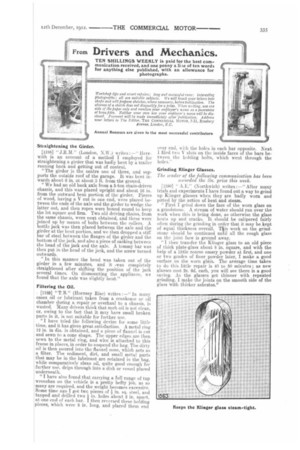From Drivers and Mechanics.
Page 23

If you've noticed an error in this article please click here to report it so we can fix it.
TEN SHILLINGS WEEKLY is paid for the best communication received, and one penny a liae of ten words for anything else published, with an allowance for photographs.
Workshop lips and smart rePairs ; long and successful runs: interesting photographs: all are suitable subjects. We will knock your letters into shape and will prepare sketches, where necessary, before Publication. The absence of a sketch does not disqualify for a prize. When nj iting, use one side of the paper only and mention your employer's name as a guarantee of bona fides. Neither your own nor your employer's name 'ruin be disclosed. Payment will be made immediately after publication. Address Your letters to The Editor, THE COMMERCIAL. MOTOR, 7-15, Rostbery Avenue, London, E.G.
Annual Bonuses are given to the most successful contributors.
Stkaightening the Girder.
[1188] " J.R.M." (London, NAV.) writes :—•• Herewith is an account of a method I employed for straightening a girder that was badly bent by a trailer running back and getting out of control. " The girder is the centre one of three, and supports the outside roof of the garage. It was bent inwards about 6 in, at about 3 ft. from the ground.
"We had an old back axle from a 5-ton chain-driven chassis, and this was placed upright and about 16 in. from the outward bent portion of the girder. Pieces of wood, having a V cut in one end, were placed between the ends of the axle and the girder to wedge the latter out, and then ropes were bound round to keep the lot square and firm. Two old driving chains, from the same chassis, were next obtained, and these were joined up by means of bolts between the rollers. A bottle jack was then placed between the axle and the girder at the bent portion, and we then dropped a stiff bar of steel between the flanges of the girder and the bottom of the jack, and also a piece of sacking between the head of the jack and the axle. A tommy bar was then put in the head of the jack, and the screw turned outwards.
"In this manner the bend was taken out of the girder in a few minutes, and it •was completely straightened after shifting the position of the jack several times. On dismounting the appliance, we found that the axle was slightly bent."
Filtering the Oil.
• [1189] "T.13." (Hornsey Rise) writes :—" In many cases oil or lubricant taken from a crankcase or oil chamber during a repair sir overhaul to a chassis, is wasted. Many drivers think that such oil is not clean, or, owing to the fact that it may have small broken parts in it, is not suitable for further use.
"I have tried the following device for sonic little time, and it has given great satisfaction. A metal ring 12 in. in dia. is obtained, and a piece of flannel is cut and sewn to a cone shape. The upper edges are then sewn to the metal ring, and wire is attached to this frame in places, in order to suspend the bag. The dirty oil is then poured into the flannel cone, which acts as a filter. The sediment, dirt, and small metal parts that may be in the lubricant are retained in the bag. while comparatively clean oil, quite good enough for further use, drips through into a dish or vessel placed underneath.
"I have also found that carrying a full range of tap wrenches on the vehicle is a pretty hefty job, as so many are required, and the weight becomes excessive. Some time ago I got. two pieces of in. sq. steel, and tapped and drilled two in. holes about. 2 in. apart, at one end of each bar. I then reversed these holding pieces, which were 8 in. long, and placed them end
over end, with the holes in each bar opposite. Next I filed two V slots on the inside faces of the bars between the holding bolts, which went through the holes."
Grinding Klinger Glasses.
The sender of the following communication has been awarded the 10s. prize this week.
111901 " A.E." (Northwich) writes :—" After many trials and experiments I have found out a way to grind up Klinger glasses when they are badly worn and pitted by the action of heat and steam.
"First I grind down the face of the worn glass on a grindstone. A stream of water should run over the work when this is being done, as otherwise the glass heats up and cracks. It should be calipered fairly often during the grinding in order that it may be kept of equal thickness overall. Tllis work on the grindstone should be continued until all the rough glass on the joint face is ground away. I then transfer the Klinger glass to an old piece of thick plate-glass about 8 in. square, and with the help of a little coarse emery powder at first, and one or two grades of finer powder later, I make a good surface on the worn glass. The average time taken to do this little repair is 40 to 50 minutes ; as new glasses cost 2s. 6d. each, you will see there is a good saving. As the glasses get thinner with repeated grinding, I make the joints on the smooth side of the glass With thicker asbestos."
























